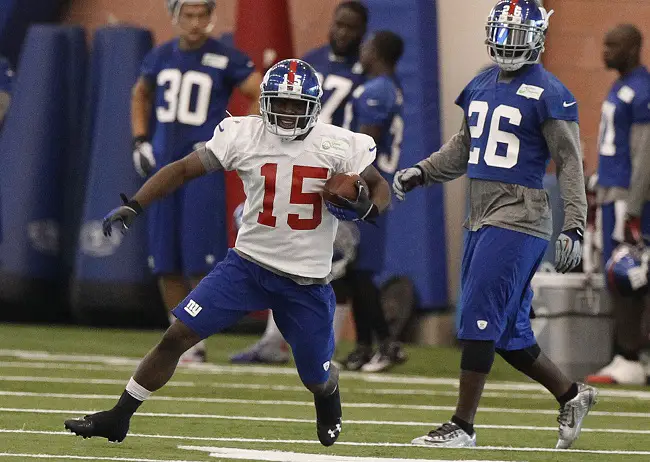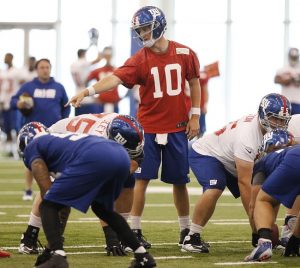[contentblock id=1 img=html.png]
Ever since Kevin Gilbride was replaced as offensive coordinator by Ben McAdoo, there has been much media and fan speculation about what the new offense of the New York Giants might look like. When Head Coach Tom Coughlin came to New York in 2004, he brought along a passing game that featured more of a vertical, down-field passing attack. His first offensive coordinator was John Hufnagel, but Hufnagel was fired near the end of the 2006 season and replaced by Gilbride.
Tom Coughlin has always been about offensive balance. He wants a physical running game combined with a big-play passing game. Coach Coughlin does not want to dink-and-dunk the ball down the field, but gain yardage in big chunks. That formula worked well for him both with the Jaguars and Giants when he had the necessary talent. And it helped the New York Giants to win two NFL Championships.
“I have great respect for Kevin Gilbride winning two Super Bowls,” said former Giants quarterback Phil Simms (1979-1993). “He was worried about hitting four of those big passes every game, and I love that about the Giants’ offense. It wasn’t 17 screens every game.”
Based on comments from current players and observations from the three Organized Team Activity (OTA) practices open to the media, the Giants are changing their style. Ben McAdoo’s background is the West Coast Offense. In a nutshell, the Giants will emphasize stretching the field more horizontally instead of vertically. Though the team will still take its shots down the field, there will be more 3-step drops and an effort to get the ball quickly out of quarterback Eli Manning’s hands. The coaches want to get Eli into a comfortable rhythm throwing the football. More passes will be intended for the running backs and tight ends at the possible expense of the wide receivers.
Ben McAdoo’s background is the West Coast Offense, serving as tight ends and later quarterbacks coach under Mike McCarthy with the Green Bay Packers.
“This offense to me, and I’ve run a lot of West Coast with Mike Shanahan in Denver, a lot of stuff is similar,” said RB Peyton Hillis on Thursday.
Hillis might serve in a similar capacity to John Kuhn in Green Bay, not so much from the standpoint of a traditional fullback, but more of a pass-receiving and rushing one-back.
“(The running back catching the ball is) going to be a big part of it,” said Hillis. “The quarterback’s going to be looking for the check down a lot this year so you have to make sure as a back that you get on your route and make sure we expect it.”
Making such a drastic change in offensive philosophy and terminology may not be quick and easy. Manning has never played in a West Coast system and neither have most of his offensive teammates. To date, the strength of Manning’s game has not been the short game, particularly screen and swing passes. And while running backs Rashad Jennings, Peyton Hillis, and David Wilson could thrive as pass receivers in this offense, the Giants lack proven talent at tight end. The interior of the offensive line has been overhauled and there are still huge health and ability question marks at left tackle and right guard.
“(The offensive progress has been) slow, to be honest with you,” said Coughlin on Thursday. “Progress is slow but steady. Some days, of course, are better than others. But, you know, we’re getting there…There’s a lot of things that have to be converted in the guys who have been here, in their minds and the new people who have not been in a system such as this, you’ve got a lot to learn. It’s a work in progress.”
“It’s different,” said Manning. “We haven’t gotten everything down. I’m not 100 percent on everything going on. There are still some learning curves and things I gotta digest and think through…I feel good about what our offense can do and the potential of it. It’s just getting to the point where we have a great mastery of it from the mental capacity.”
So the key question is when will the players become comfortable enough with the new system to where the learning curve does not cost them on the playing field? It could take the entire preseason. Worse, it could take the first half or even a full season of actual game experience.
But once the system is learned, it could make life a lot easier for Eli and his receivers.
“I would think the West Coast Offense and some of (that philosophy) will help (Manning),” said Simms. “Give the quarterback 50 percent of his completions as ‘gimmies.’ There are other times you want to make those four or five special throws.”
In the new system, run-after-the-catch ability will be paramount. The good news is the Giants have some extremely dangerous receivers with the football in their hands, including Victor Cruz, Rueben Randle, Odell Beckham, Jerrell Jernigan, and Trindon Holliday.
“The ball is coming out quick,” said Manning. “It does fit my style of play, getting in rhythm, knowing where to go, making smart decisions. Getting the ball into receivers’ hands, let them be the athletes. Throw the little 6 or 7 yard pass and let them make big plays.”
While all pro offenses use pre-snap and post-snap reads, based on early comments from the players, there will be fewer reads in this offense. That should make it more likely that quarterback and receivers are on the same page, causing fewer mental mistakes that turn into turnovers for the opposition. In particular, receivers such as Randle and Jernigan, who were very inconsistent in the old Coughlin-Gilbride system, may perform much better with fewer reads.
Jernigan was asked if there were as many reads as under the old system, “Not at all. We’ve got a couple reads but we don’t have that many reads…you can go out and play faster and get the thing going and don’t have to think that much.”
“I’m liking (the new offense), it’s going to be pretty exciting,” said Randle on Thursday. “Coach McAdoo has done a great job putting us in positions to make plays and using our abilities…Everything is pretty much black and white, it’s simple. What you have is what you run. Just take a lot of things off our minds and go out there and play football and just use your ability to get open.”
“(There are) not as many reads,” continued Randle. “When you can go out there and maintain that focus on one specific thing it allows you to go out there and play a lot faster. That’s what we’re doing here. I think that’s going to be key for us pushing forward to make more plays… We just want to make sure we’re all on the same page.”
“(The new offense) frees me up a lot,” said Randle. “Just go out there and do what I do, just create separation and make plays. I had to really focus on reading than looking all over the field, just running routes. I think we’re all happy to be a part of that type of offense.”
Beckham, Jernigan, and Holliday are all particularly dangerous after the catch. Again, the learning curve will be an important factor. Beckham’s growth has been stymied somewhat by an early hamstring injury that caused him to miss most of the OTAs.
“It’s been tough to go from such an easier offense at LSU with the digit system and stuff like that and then going back to the concepts, which I was in my freshman year,” said Beckham. “It’s actually not that bad once you get into it and you break it down by formation and things like that. It’s really not that bad. It’s just a lot of memorization.”
While the West Coast Offense does place more emphasis on throws to the running backs and tight ends, one would think that Coach McAdoo is drawing up plays that would have Randle and Beckham outside with Cruz, Jernigan, and/or Holliday in the slot.
“(The offense is) a lot different but it goes back to some of the same concepts I had in college in the spread (offense) with Troy (University), so it’s going good, just learning different signals and stuff,” said Jernigan. “We used to go five-wide the whole time (at Troy University) so it’s back to what I’m really used to.”
“I think it’s an offense that fits my game and also spreads the ball out to everyone and gives everybody the chance to make plays,” said Jernigan. “Just get the ball to your playmakers and let them do the rest in open space against defenders.”
“(The spread offense) just allows you to use your playmakers instead of just going with your traditional two-wide set,” said Beckham. “You have four receivers on the field and you’re running routes and you’re all working with each other to get each other open. It definitely makes it a lot more fun for us.”




Sorry, the comment form is closed at this time.